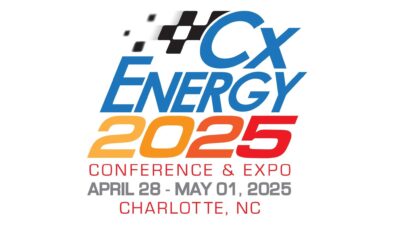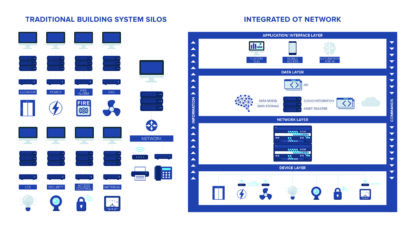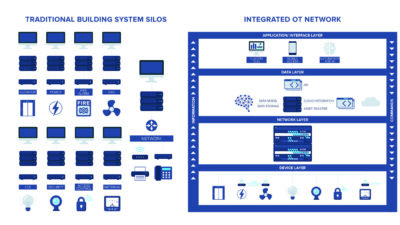Paralleled generator systems provide many advantages, especially for large, power-dense applications. Designing the most efficient and reliable system for a specific application requires a solid understanding of the options available.
This article summarizes some of the key points and design criteria involved in designing a paralleled generator system for capacity, redundancy, and reliability in critical operations. It also covers some of the compatibility issues related to critical electrical distribution systems that include both generators and UPS systems.
Critical installations can be classified using a tiered system, with Tier 1 being the most basic, offering the least amount of redundancy and uptime, and Tier IV being the most complex and expensive, offering the most uptime and reliability. With the emergence of Tier III and Tier IV data centers in the 1990s and the early 2000s, engineers began specifying paralleled generator systems to increase the redundancy of the generators to N+1 and greater, as required for these higher-tiered data centers (for the Uptime Institute’s definition of Tier III and Tier IV data centers, go to www.uptimeinstitute.org ).
Although a design also can achieve the required redundancy from the generator through standard automatic-transfer switches (ATSs) and downstream interweaving of dual cord servers, there are many reasons why a paralleled generator system may be preferred, including:
-
At less than 100% of design load, more than N+1 can be achieved with paralleling gear. For instance, if the total data center load is 10 MW and five, 2 MW generators are paralleled to achieve the (N) load, six generators would be paralleled together to achieve N+1. If the actual build-out and usage of the data center was only 80% of the design load, the total load would be 8 MW. Four, 2 MW generators could supply the load, so with six total generators, the system would achieve N+2 redundancy. Independent strings of generator backup systems would not be able to handle an outage of two generators without affecting critical loads, even at 80% of the design load.
-
Depending on the configuration of the electrical distribution system, a paralleled system can achieve the required redundancy using fewer total generators than a system with individual strings of electrical components.
-
Load-bank testing the generators is much simpler. An additional spare breaker can be added to the lineup of generator breakers. The generator tie breaker to the utility board and all the generator breakers (except for the one feeding the generator to be tested) can be opened. By keeping the breaker for the generator to be tested close, all of the generators can be load-bank tested from a single fixed load bank. This is an easier procedure than the one required for a system comprised of individual strings of components.
Load-bank testing is an important criterion for ensuring proper operation of critical generators. It is typically recommended to exercise the engine monthly with a minimum load of 30% of the standby power rating, or loaded to recommended exhaust stack temperatures. Generators tested at no-load or loads less than 30% of standby rating for long periods of time can develop wet stacking or carboning caused by incomplete combustion and incomplete burning of fuel.
-
There are no distributed ATSs in the electrical distribution system, thus reducing the amount of valuable floor space required.
-
Paralleling gear can potentially accept more than one utility feeder for additional redundancy and uptime.
-
Generators can be paralleled together to the utility power service in either an open (break before make) or a closed transition (make before break). If closed transition is used, it can eliminate the “bang” on UPS batteries that takes place during testing and retransferring from the generators to the utility, thus preserving battery life.
The engineer must coordinate with the utility prior to adopting a closed-transition system. Most utilities are concerned with these systems and will provide much scrutiny over the intended usage and relay protection.
-
Paralleling gear can employ soft-loading transfer. When using closed transition, the transition period can be programmed to last for several seconds. The frequency of the generators is matched to the utility under synchronization and paralleled operation. When transferring from the utility to generator, the frequency of the generators can be modified slightly during the parallel operation to slowly increase the load to the generators. This will reduce the heavy step loading on the generators during testing mode.
-
Generators can be rotated during usage. Rotating the (+1) unit allows for equal run times among all the generators.
-
A priority list of most-critical to less-critical loads can be programmed into the paralleling gear’s logic. The control logic can be incorporated into downstream ATSs and/or building automation systems to turn off less-critical loads in a situation where more generators than the redundant generators fail and cannot support the entire load. Without this function, the generators could go into overload and potentially fail outright.
ISOLATED BUS OPTIONS
Paralleling gear also can be used to provide additional capacity, by paralleling two smaller generators to meet the load that a larger generator would provide. This system, called isolated bus, does not incorporate the utility feeder into the gear. The generator distribution is mated up with the utility power downstream at the ATS.
Isolated-bus paralleling gear can be used when the total load exceeds the capacity of commonly sized generators. Currently, few manufacturers offer 1,800 rpm, diesel-driven reciprocating-engine generators in sizes exceeding 2,500 kW. For total loads in excess of 2,500 kW, a paralleled system can be used.
Even at a total facility load that does not exceed the capabilities of a single generator, a two-generator system with paralleling gear can offer more reliability. In this situation, failure of a single generator will only take out half of the system’s backup capacity—not all of it. As discussed in the last bullet point above, control logic can be used to switch off some of the less-critical loads in the event of the loss of one of the two generators.
Although isolated-bus paralleled systems do not offer some of the advantages of utility-paralleled generator systems, they do offer more flexibility than nonparalleled systems.
GENERATORS AND UPS
For critical installations that will include both standby generators and UPSs working in tandem, compatibility issues must be considered during the design and construction phase.
Different loads affect the sizing and the performance of generators in various ways. Loads that require high initial inrush and/or loads that are high in harmonic content will require a larger generator. Devices using silicon controlled rectifiers (SCRs) to chop up the ac waveform will provide a nonlinear waveform. This nonlinear waveform (harmonics) will cause voltage distortion across the generator’s reactor and can cause unacceptable transient performance. This will adversely affect the performance of the entire electrical distribution system.
UPS rectifiers usually do not draw a sine wave current from the power source. The greater the current waveform is different from the sine wave, the more total harmonic distortion (THD) the waveform contains. Harmonic distortion can cause excessive heating at the generator and excessive voltage distortion across the entire system.
UPS and generator manufacturers use various methods to make their UPS systems more user-friendly to generator systems. These include the following:
-
12-pulse rectifiers in lieu of 6-pulse rectifiers. A 6-pulse rectifier will typically have about 30% THD, rich in fifth and seventh harmonics. A 12-pulse rectifier will have less than half of the THD experienced with a 6-pulse rectifier, and is rich in eleventh and thirteenth harmonics.
-
Passive filters. Passive filters can reduce THD experienced by the generator. At low loading on the UPS, the passive filter can provide an excessive capacitive component that will be sent back to the generator. Unlike a utility source, a generator cannot absorb the voltage rise caused by the capacitance in the system. Theoretically, the generator’s voltage regulator can lose control and raise the output voltage to the UPS. The UPS rectifier may turn off when it sees the rise in voltage. This disconnecting of the UPS rectifier will remove the additional capacitance in the system, which will allow the generator’s voltage regulator to operate properly. This cycle can continue, and the UPS will be unable to pick up the load under generator power.
This problem can be eliminated by using a smaller filter, sized to provide no excitation at the lowest possible load. In addition, the filter can be completely removed under generator power with control circuitry. Strategically providing reactive loads in the system and connecting them to the generator prior to the UPS will enable these loads to absorb the capacitive component, essentially redirecting the capacity component away from the generator.
-
Step-loading or “walk-in” features. One hundred percent step-loading of the UPS system to the generator will cause sudden fluctuations in both frequency and voltage of a standby generator if utility power is lost.
To combat this problem, many manufacturers offer a “walk-in” function. During a utility power outage, the load served through the inverter output from the utility source via the rectifiers will immediately switch to the UPS batteries. Once the generator is up to speed (voltage and frequency), the total load on the UPS system’s batteries slowly can be applied to the generator over time. This typically can be programmed to occur over a 30-s period. This “walk-in” feature greatly reduces the frequency and voltage fluctuation on the generator output.
-
Permanent magnet generators (PMGs) with digital excitation controls. UPS harmonics can cause voltage waveform distortion at the generator. PMGs that derive their own excitation can help mitigate this problem. In addition, digital voltage regulators and digital excitation controls can provide more immunity to the harmonic effect of nonlinear loads.
-
The ability to set maximum input current. Many UPSs will allow the operator to set the maximum input current. After restoration of ac power, the rectifier/battery charger will power the inverter and simultaneously charge the batteries. The maximum possible input current to the UPS must be considered when sizing the generator. If an operator reduces the maximum input current, the total load on the generator will be reduced, but the time to recharge the batteries will be increased.
In addition, a UPS can be damaged if it is transferred rapidly with an out-of-phase source. When power fails, there is an outage of several seconds before (1) the generator starts and produces appropriate voltage and frequency levels, and (2) the ATS transfers over to the standby source. Once the normal source returns, the typical contact open time for a mechanical ATS can be up to 10 cycles. To protect the UPS, an intentional time delay of 1 to 3 s is recommended when transferring between out-of-phase standby (generator) and normal source (utility).
When designing critical systems, the engineer must ensure proper levels of frequency variation when under standby power. A generator is much more susceptible to voltage and frequency fluctuations with large load changes than a utility is. A UPS can be susceptible to slew rates (rate of change of frequency) of 1 to 2 Hz/s. Some UPS systems are designed with a solid-state bypass switch to allow for a very quick transfer to input power (via bypassing of the UPS inverter). To achieve this static transfer, the UPS must remain synced with the input power. UPS loads cannot tolerate slew rates exceeding 1 to 2 Hz/s and will not be able to sync with the input power. Failure to sync will require the static bypass function to be disconnected. Frequency disturbances from the generator can be controlled by limiting heavy block loading and stepping the loads.
These are only some of the problems that can occur when designing critical electrical distribution systems that include both standby generators and UPS systems. Proper specification of both the generator and UPS components is essential and will ensure the desired level of power quality and uptime.
Reducing voltage distortion
A solid-state starter will cause voltage distortion across a generator’s alternator. This distortion is caused by the nonlinear way the silicon controlled rectifiers (SCRs) in the solid-state starter draw current. The alternator may have to be oversized to compensate for this voltage distortion.
UPS systems, like solid-state starters, are a nonlinear load. UPS systems use SCRs to convert ac voltage to dc voltage to charge the system batteries. Increasing the size of the generator’s alternator is required to minimize the overheating that occurs as a result of the harmonic currents induced by the rectifier. A larger alternator also will minimize electrical system voltage distortion by lowering alternator reactance.
Paralleling gear with multiple generators can be used to provide additional standby capacity. Paralleled generators also provide for a lower amount of impedance in the system. With lower impedance, the voltage distortion across the alternators is reduced.
Generator sets are a high-reactance power source compared to the serving utility source. The fact that a standby generator is typically much smaller in size (kVA) than the serving utility power source only exacerbates the impedance difference between the two sources.
The serving electrical utility will size its transformer to feed the entire building load. Standby generators are typically sized only to supply critical loads and/or emergency loads. Standby generators may have a subtransient reactance in the magnitude of 5 to 75 times greater than a normal utility source transformer. Generators must be sized for nonlinear loads in order to decrease voltage waveform distortion and heating. Nonlinear loads may operate properly on the utility source, but may respond poorly when fed from a standby generator source. Using an oversize generator to reduce reactance may be advantageous. To obtain a significant reduction in harmonic distortion, major oversizing must take place. The reactance will be cut in half when the generator size is doubled.
| Author Information |
| Lane is a principal and the chief electrical engineer of Lane Coburn & Associates LLC |



